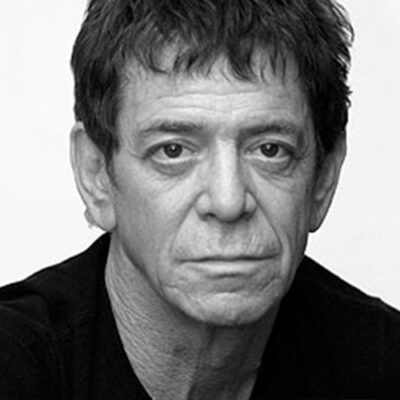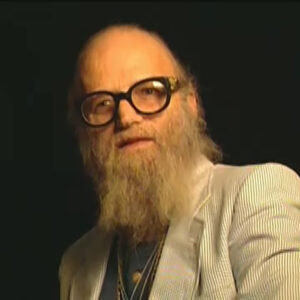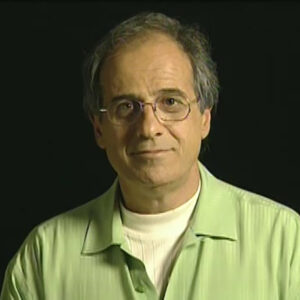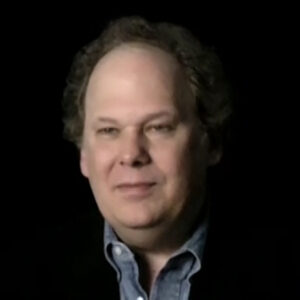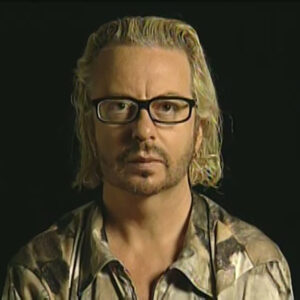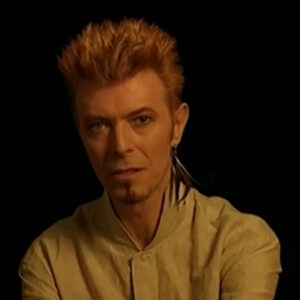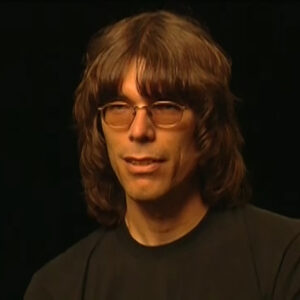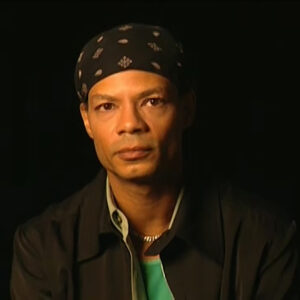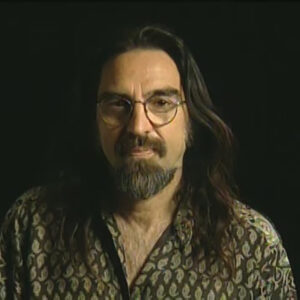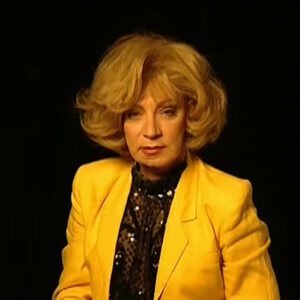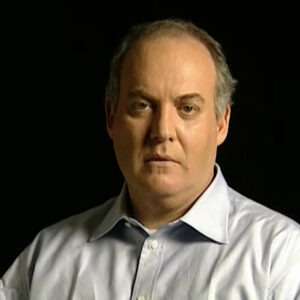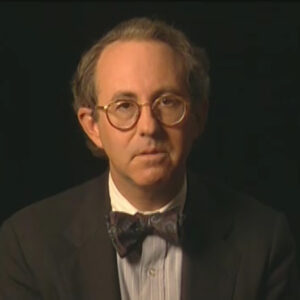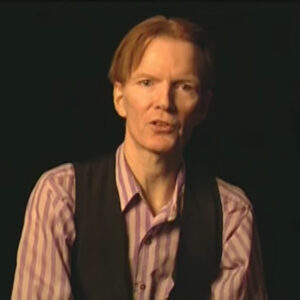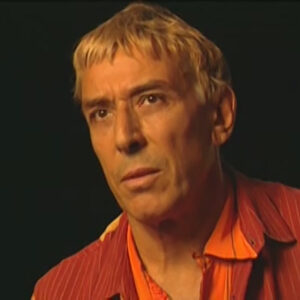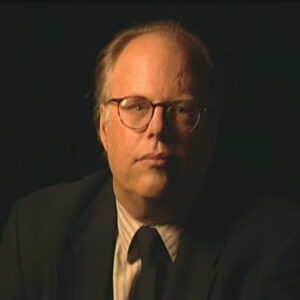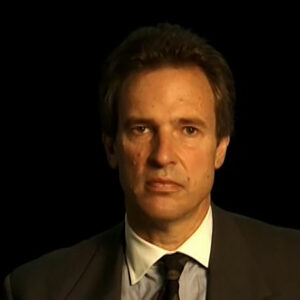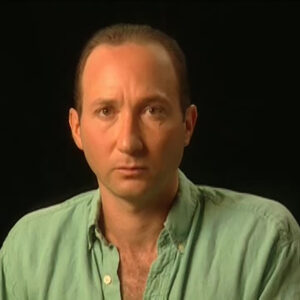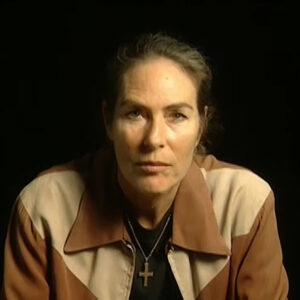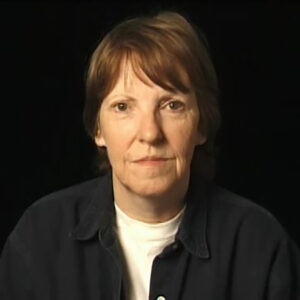Speaker A friend of Lou’s in mind, Bob Rubin, who was kind of catalyst in the underground film scene pressuring one day, and she was very excited about wanting to take me to see a rock group down in Greenwich Village at the Cafe Bazaar. So I went down with Barbara and I happened to have a whip with me, which I used as a decoration. And I kept it sort of fastened around my belt. And when I got down there, the Velvets were playing.
Speaker Was on by land of Iola and.
Speaker Somewhere in the course of the set that they were playing to. I notice that no one was dancing. So Barbara kind of encouraged me to get up and start dancing. And I was a little shy at first. I didn’t know because there was no stage separating the Velvets from the audience and they were kind of tables shaped and a kind of horseshoe ensemble and people were sitting around in that area. And so I felt that I was maybe intruding a little bit. But Barbara kept on nudging me to get up there and start dancing. So I did. And about five minutes after I was dancing and I pulled my whip out and I was dancing with the whip, people started getting up off each of their chairs and joining me on the floor in front of the Velvets while they were performing.
Speaker So it was it was only during the break between sets that at the time when I was introduced to John and Lou, that they were really thrilled that I had gotten up to dance because they said that no one likes to dance to their music. And they encourage me to come back and dance again. And so I came back a few days later with Barbara and I encouraged Andy to come down. She. Barbara wanted to have Andy listen to the Velvets also.
Speaker And so Andy and I went down with Nico and I think Paul Morrissey and a few others at the factory. And it was the second it was a second meeting, actually, my second encounter with the Velvets.
Speaker And tell us about what that was like when you’re with your.
Speaker That would have been probably October of 1965. I believe somewhere in that area and kind of early fall, late, late fall, December, December of 65.
Speaker You could have been early December maybe. It seemed like it seemed like warm weather.
Speaker So if you could start over again, this created my official maybe.
Speaker Yeah. Where did you get those winds? You got them back. Was that from our book guy?
Speaker If you were to say that, maybe this summer. Yeah. Do it. OK, Andy.
Speaker Well, it would have been around early December of 1965 that Andy and I and Paul and a couple of other people from the factory went down to see the Velvets. The second time around, again, Barbara and I brought Andy down to hear the Velvets.
Speaker And just what the idea of Andy exposing Andy to another element of what was going on in the art scene. There was no preconceived notion on his part. There was a plan. He was in the process of putting together a retrospective of.
Speaker Films that he had made with E.T., Cedric. Jones sneakers had approached him earlier that year about doing a retrospective at the film maker Cinematheque. And it was during this encounter that Andy had with the Velvets and then having invited them back up to the factory, you know, like a week later, that he somehow we came upon the idea of doing some kind of a multimedia and mixed media event rather than just keeping it limited to an 80 Sedrick retrospective whereby the Velvets would actually play live in front of some of the movies. And I would be there choreographing the songs and Dancing with the Whip and. And that would be the opening part of the retrospective, in a sense, and then it would go on to maybe two films after that. So was the mall, the multimedia mixed media opening, and then it would be followed by one or two films each night for about a week.
Speaker And that is what became the way it started out.
Speaker It actually started out being called uptight.
Speaker Or Andy Warhol uptight and then the name was later changed to the exploding plastic inevitable.
Speaker And then I know that in January of 66, you are a psychiatrist at the jail. You can talk about that.
Speaker Yeah.
Speaker And he was approached, by the way, I figure what they would call the Association of Psychiatrists or the American Psychiatrists Association. And every year they would have a function, a different kind of venue for their members. And this year, they somehow got in touch with A&E and were had approached A&E about. Doing something for the convention and Andy came up with the idea that let’s let’s bring this this program that we’re. That was basically in its trial run and use it as a stage event at the convention. And again, it was sort of connected with the uptight situation. Bob Rubin and I were running through the audience with movie cameras, you know, putting movie camera, shoving movie cameras in the faces of the audience. And that’s what the uptight aspect was, was to create a kind of anxiety ridden, uptight situation within the audience. And so this seemed to be the perfect kind of arrangement to do it with psychiatrists. And again, I was 80. Cedric was my partner at that time. And there’s some movie footage by Janis Makers documenting that. And it was written up in The New York Times.
Speaker And I think we literally drove almost everybody out of the out of the ballroom or was held at Delmonico’s Hotel at the time in the ballroom. And the psychiatrist couldn’t made could make out a tale of it. They were just totally blown away by this whole situation.
Speaker We cut from. Tell me when you’re ready. OK.
Speaker So there was a psychiatrist. Sorry.
Speaker There was a there was a convention of psychiatrists in New York in early 1966 that approached Andy about doing a program.
Speaker At their annual dinner at the Delmonico Hotel.
Speaker Perfect. OK. So let’s go on a little bit. I’d love you to talk about. You are you are a poet and Lou is a poet and writer, I talk a little bit about how.
Speaker You feel his writing is so talk about his writing.
Speaker And use his name.
Speaker I always regarded Lou Reed as a kindred spirit of sorts, partly because of his association. With a former teacher of his at Syracuse University, Delmore Schwartz. Who is a poet whose works. I was fully aware of at the time, and so I found that a kind of fascinating connection, that here was a young poet my age who was who was a product of that sensibility and that connection, as it were. And he and Luke Cat confided in me. About Delmar’s later years, because there was very little known about him, he had become almost a recluse to a certain extent. And then there was through, Lou, that I found out that Elmo was living at the Dixie Hotel in the Times Square area.
Speaker So it was actually an, I believe, late spring or summer of 1966 when Delmore died. I. Took blue to Delmore, his wake at the funeral home on Second Avenue near St. Mark’s Church.
Speaker Lou, he was not aware that there was a wake for Delmore. So and I had never met someone. So I actually Shapp around Lou to the wake. And there was Delmore in an open coffin in the funeral home. And then, Lou, somehow a former classmate of Lou’s recognized Lou Ann in the crowd. We were standing outside after the work and Lou got the I got the invitation of going out to the funeral to the cemetery. So he got pulled into a limousine that whisked away. And there I was standing at the street corner.
Speaker That’s fabulous.
Speaker And now there is a book of poetry that was going to be published, all the pretty people call this.
Speaker Lose, lose everything I was there was some stuff to lose, it was never published that you were involved in that.
Speaker Am I getting it?
Speaker No. That’s a very long invalided story, though. It really has to do with back to back, Chris. I mean, they’re not talking.
Speaker So can you talk a little bit more about the multi-media nature of the API?
Speaker Sort of describe for us what was going on with the slides, with the whip dancing, with sort of really bring us into that. And kind of set the stage of what time period this is.
Speaker I think tha the nature of the multi media aspect of the API.
Speaker Had a lot to do with the idea of Andy wanting to create a kind of three dimensional type of art that would encompass various sensibilities from from the different genres and approaches to putting together an ensemble. So that would include motion picture slide. Live music. Choreography. And to combine it in such a way where we’d have an amazing impact on. The the audience that was there and a sense where the audience could almost participate in this really basically took place in a in a very large hall on St. Mark’s place called what was later called the balloon farm.
Speaker It started out being called a dorm, but that was a small basement beneath the balloon farm. And then later we later brought it up upstairs and.
Speaker It was comparable to, I guess, the Fillmore Western assets, where after after the Velvets played there, then there was other live bands that would come in from time to time. But we initially opened up that space.
Speaker And tell me who was.
Speaker Who was there, who was dancing? What kind of supplies there were?
Speaker Well, we saw the slides for the EPRI were basically put together by Paul and Andy and myself. They were they could have been photographs of cut outs from magazines. They were kind of colored acetates that had a kind of geometric design. They were the the opposite of. Let’s say psychodelic, so they didn’t have that kind of psychedelic feel to it, they had a more kind of fashion oriented New York feeling as opposed to a West Coast feeling.
Speaker And those slides were projected on top of the velvet’s as they were performing at the simultaneously the black and white movie footage was projected also on top of the velvet. So you had this combination of live figures on stage, in front of this combination of coloured slides and black and white motion pictures. And then I came in with the with the dancing, the choreography for the for the live music. So there was a lot of activity and a lot of energy happening on stage.
Speaker At the same time and.
Speaker And it was it was a pretty amazing effect for the for the audience.
Speaker Can you tell me a little bit about what you think this is? First, the light shows.
Speaker It was. It wasn’t. The EPA was not the first of light of the light showers, but it was it was a different kind of light show as opposed to what we later discovered when we were out on the West Coast and we performed it at the Fillmore West and we saw the kind of light shows they were doing. They basically had gels and liquids in it and a glass plate that was projected through a light projector on the screen.
Speaker So it was a totally different sensibility, actually, than the kind of light show that we were basically putting together at the time.
Speaker And I know you went on tour with the exploding plastic. You talk about that. And also especially the strangeness of this group compared to the West Coast sensibility, the contrast of New York.
Speaker Well, the I think there was a contrast between West Coast, the East Coast in terms of the rock and roll and and multimedia sensibility. That had a lot to do with the New York aspect.
Speaker Was there a black and white? Very kind of underground. The the West Coast aspect of multimedia had a lot to do with psychedelic soul blazing colors. It was. It was just a different approach to. I guess a different approach to the audience reaction and how the audience responded. We took our show on the road. We we went to many universities and colleges and art centers in various parts of the country. I mean, we didn’t we didn’t have a very long tour, but we we went out whenever there was the the invitation for us to go some way to perform.
Speaker Can you just say that again? We were. We were.
Speaker Right, then there are the Velvet Underground and the exploding plastic inevitable, the whole team, which really included Andy and Paul Morrissey, Danny Williams, who really took care of the lights.
Speaker The members of the Velvet Underground. Lou Reed, John Cale, Maureen Tucker. Sterling Morrison, my dancing partner with the time was Mary Warren off. And we would take this show on the road to universities and colleges and art centers in various parts of the country.
Speaker Perfect.
Speaker Can you talk a little bit, I know that they got busted, I guess, because the dancing or something.
Speaker Talk about that and you all stay away from our first really big important gig was at a club called The Trip in Los Angeles on the Sunset Strip.
Speaker And we will be back there with the mothers of invention lead lead leader of that group was Frank Zappa. Because MGM Verve Records was Bert was initially public publicizing both the Velvets and the mothers with their first piece. So this was a good opportunity to combine the two groups within one venue and within, I think it was on the second night. Of our performance at the trip. There was a dispute between two partners of the trip and the US state sheriffs came in and put padlocks on the door. But because of there was a union rule that not a to collect payment on our contract, we had to remain in L.A. for the duration of the performances that we would have done, which would have spanned over a two week period. So we basically we had already arranged to live in a place called the Castle, which was in the Hollywood Hills. So we basically relaxed for about a couple a week later while we were waiting to fulfill our obligation on the contract through the union rules.
Speaker And it was during this time that Bill Graham approached us who came down from San Francisco and put the Velvet Underground and the exploding plastic inevitable evitable and to the Fillmore West. In San Francisco, and so I was on that occasion that, again, the program consisted of the Velvets and the mothers.
Speaker But the but Bill Graham did not tell us that the opening act would be the Jefferson Airplane. And basically he was exploiting the situation to promote the Jefferson Airplane because we did know that the Jefferson Airplane was going to open up the evening. And he really had a kind of.
Speaker Bad feeling or a negativity towards the velvet’s, he never really liked their music to begin with. And so we felt a bit exploited by that.
Speaker Before we talk any more about that. Yeah, it’s one thing in L.A..
Speaker A lot of people saw those concerns, I think Jim Morrison. I think so. Is that right? Yeah. Remember you talked about any of those people. What do you think?
Speaker Well, I think Jim Morrison came on the first the second night of our performance at the trip in L.A..
Speaker I believe he was a student majoring in filmmaking at UCLA.
Speaker And as I was told, I don’t know if this is true or not, but I was told that because of my performance on stage that he kind of modeled himself after me and adopted my look in black leather trousers.
Speaker And his whole packaging idea sort of was inspired by what I was doing at the time.
Speaker Can you talk about what the ban looks like?
Speaker We we. There was really no charisma in the group except for Nico. I mean, we were not we didn’t have costumes.
Speaker I mean, Lou was dressed in a dungaree jacket, black denims. Thanks. I think John Cale was the only one I kind of had a kind of fashion shake about him because he he had he had some of these pieces of jewelry that Kenny Lane had designed that he had given given to the group to wear during the performances. So. So other than John and Nico, I mean, as the rest of the group really remained in the background in terms of any kind of charisma. So we didn’t have any other kind of flashy costumes that you would normally see in other groups.
Speaker Talk about Nico.
Speaker I think it was Paul who felt that the band needed someone, some kind of charismatic character in the group, and I think it was Paul’s idea to pull Morris’s idea to.
Speaker Bring Nico in the group. I think initially, Lou and John were kind of hesitant about bringing Nico into the group. But Andy kind of encouraged Lou to write some songs for Niko’s to tap or do something in an act, had to have an active role in a group rather than just be standing there banging a tambourine. So Lou relented. And I think he ended up writing two or three songs in a.. Are all tomorrow’s parties. I’ll be a mirror.
Speaker And it might have been one or two others.
Speaker And Marina, this woman.
Speaker Well, Maureen took over from a very interesting connection, Emma.
Speaker Maureen Tucker took over from Angus Glees, who was the initial percussionist in the group. But Angus was hell bent on just trying to create a kind of artsy music group where where Lou is more rock and roll oriented. And so there was really a difference between them and there was a parting of the ways, as it were.
Speaker And so Maureen was brought in to serve for.
Speaker Angus police who went on his own developing his own music career. So it was just kind of a divine accident that here we had a woman drummer in a grill, probably the first woman drummer in a rock and roll group. To my knowledge.
Speaker Do you remember the connection that was raid? I think it was Sterling’s roommate.
Speaker Yeah, I’m fuzzy on that, actually.
Speaker If we can jump back into everything else, Karen, from that period, are we saying words, names?
Speaker But I have a couple of things here.
Speaker Jump in here. You’re so good at your art. Oh, yeah, it’s fabulous. Just perfect.
Speaker OK.
Speaker Remember, the party at Phillip Johnson is. We’ve got Steven has some wonderful photographs.
Speaker Well, it’s a little apart, is a little fuzzy. I mean, we were there, too. We were the hired hired hands.
Speaker We go back and you’re right. I talk about we can back this convention. Yeah.
Speaker What was it? What were this? Do you remember any sign that the viewers or even if the dog was particularly responsive people, so they would always come on and everybody would really.
Speaker Well, there was there were two or three songs that were really the mainstay of our program. There was. European sun that was dedicated to Delmore Schwartz, it was basically a long fifteen, 20 minute instrumental piece.
Speaker That’s on the first LP.
Speaker And with that song, I just I just have a bag of tricks that I would use different props and just do a lot of improv dancing to the other two songs that really made an impression on the audience were. Venus in Furs, which is directly connected with the whip dance that I devised. And then the other song, which was quite exciting, actually, was heroin. Now people believe that I was actually shooting heroin on stage, but that was not the case at all. I actually use use. I would use a ballpoint pen. I would use a pencil. I would use that as a substitute for a hypodermic needle. And I had the belt and I would go into the motions that all the the gestures and attitude of shooting up. But I wasn’t shooting up at people. Somehow I thought I was because of where I was situated onstage. I couldn’t see what I was doing properly. So but that was that was a big a big hit with the audience. I mean, there was a lot of frenzy. The music would get to a very high pitch and and all hell would break loose. And people were just dancing all over the place.
Speaker Can you talk about the sound that you think is so extraordinary? We now know that so many bad.
Speaker Well, let’s say it’s a very peculiar and interesting tracing of of the of the Velvets career.
Speaker First of all, the Velvets as a group only existed for five years from nine basically 1965 to 1970.
Speaker And it was only years later that a whole new generation of of young rock musicians know playing out of their parents garage caught up with the Velvets and sort of became influenced by a lot of the music that the Velvets had done earlier on. So it’s kind of interesting that the the Velvets took on this kind of mythic stance in the rock and roll for group that didn’t even exist at the time that the influence was happening.
Speaker One of the things, of course, it’s impossible to determine if Lu had not had a solo career after developments.
Speaker I wonder if you could comment about whether the Velvets would have been picked up? As much as I kind of think that by Lou continuing on it, kind of. And there was releasing more of the Delbert’s stuff as he continued as a solo artist.
Speaker Well, I think that’s that’s interesting. I think that.
Speaker By Lou having left the group in 1970, and he did it in a way that he had to really.
Speaker Go into seclusion and think about what he was going to do for himself from the future.
Speaker I think had the Velvet survived much longer than they had, I think their impact would have been lessened in terms of any kind of influence. But who’s to say? I mean, it was just it was just the sheer faith that things fell in place the way they did in the velvet’s didn’t exist after 1970.
Speaker And yet they they took on this kind of mythic stance of being an influence on on a lot of groups that came in after.
Speaker So it’s hard. It’s really hard to say. It’s hard to trace. It’s hard to predict what might have happened in hindsight.
Speaker But do you think that they they’re performing and performing? This song brought new audiences to develop its.
Speaker Yes, I was kind of reminded people who had not heard the velvet’s before.
Speaker So we know what we’re talking about.
Speaker I think that I think that by Lou performing. Certain of the songs that were. Composed during the time of the Velvet Underground. I think that by Lou performing these songs solo. It kind of reminded a whole new audience and a whole new generation. Of The Velvet Underground’s importance to the music.
Speaker That’s wonderful.
Speaker You were there, I think, at the last concert at Max’s in August 1970.
Speaker Yeah, I when I was with Brigitte, actually. We were there as a day start over. Describe.
Speaker Yeah, I went to I went. I remember meeting Brigitte at her little hotel at Brigitte Park, at her little hotel room at the George Washington Hotel. And she had a tape recorder and we went over to Max’s. I think it was performing live at Max’s. This is one of the first times that this had occurred, actually. And it was in. So I think it was in August of 1970. And in any case, it was during the summer. And Brigitte had taped. Not knowing, but at the time had ended up taping the last live performance of the Velvet Underground with Lou because they were going to Max’s Kansas City with Bridget.
Speaker We were out. We were out on a date that night and she had a tape recorder with her and she wouldn’t invariably carry it. Reverend, she went and we happened to go to Max’s that with the velvet Velvet Underground was performing. And she happened to take the performance, not knowing that this was gonna be the last live concert of the Velvet Underground with Lorraine, because it was it was at this concert that Lou then broke away from the Velvets. So the it was just by fate and chance that that this this cassette recording of the Velvets technology at that time being so poor was able to capture what would become a moment in history in terms of the Velvets last actual performance with Lou Reed.
Speaker Perfect, perfect, perfect. Do you want to say anything about Bridget?
Speaker Or maybe about Warhol and how everything was taped and everything was photographed and you get into that a little bit.
Speaker Just point.
Speaker I don’t know if it has too much to do with the velvet steroids. Like I missed another.
Speaker Can you talk about Andy and his and what you think his influence on?
Speaker You were there? Well, I it it’s it’s.
Speaker It was interesting to observe how Andy and Luke kind of interacted with each other because basically you had two two extremely gifted individuals that each had almost lacked an ego. And yet they were expressing their egos with each other because Lou would be sometimes Lou would be very resistant and sometimes Andy would be very encouraging to suggesting to Lou that he should do this or try that. And it was kind of interesting to watch the two of them circle each other in that fashion where there was there was no ego involved in terms of how one would influence the other.
Speaker So it was it was sort of. The two of them being open to each other to such a degree that it would allow for a lot of creativity to filter through.
Speaker What was he like?
Speaker Well, and he was, as I said, because he he kind of lacked an ego. He was almost the nonexistent producer, as it were, just his his presence.
Speaker Enough was kind of an inspiration or an encouragement to the group in terms of allowing them to be who they were. And in a studio setting. I think part of Varney’s role as a producer was basically that he was he was paying the rent on us on the recording studio.
Speaker I know you talked about how great it was.
Speaker He wouldn’t let anyone else touch the stuff. They say, well, let’s do this then. It’s really great.
Speaker Let’s talk about that a little bit.
Speaker Well, it’s it’s sort of out of my expertise, as it were. I mean, I could.
Speaker And his personality, the way you see it that way.
Speaker The I think that I think it had a lot to do with the technology of recording music in a studio. So, Andy, just like the kind of one on one ratio with the music as he as he had done with the film making, was to record it the way it was and leave it the way it was without tampering it, tampering with it in any way that would change it to change the kind of authenticity of what that what that feeling was.
Speaker And can you talk about life at the factory, sort of when you got there, what you did, the screen test? Let’s talk about that a little bit. Were you involved in that? Was it.
Speaker Yeah. Yeah, that well, the Skippy. The screen test started within the screen tests was as a collaboration, was an outgrowth actually of a of a portrait sixteen millimeter, a three minute portrait that Andy made for me. Allow me to be used as a publicity shot for a book of poems. And through that format, the screen test collaboration evolved out of that, where we did many three minute portraits of various people. Some of these screen tests that are being compiled under 50 Fantastics, 13 most beautiful boys, 13 most beautiful girls. Basically, they were all part of a screen test format, which was a collaboration at the time.
Speaker Of the people that we did between three, four, maybe up to 500 different people.
Speaker I mean, I can’t keep track of them all. But there are some of the luminaries were Marcel Duchamp, Allen Ginsberg, Francesca Scavullo.
Speaker It is Sedgwick. Salvador Dali.
Speaker A lot of poets. Ted Baragon. Ron Padget.
Speaker Fashion model Merza Barrence and Benedita Barzini. Each one would sit in a chair for three minutes and look at the 16 millimeter movie camera and. To whatever. You wanted to do. Mostly people would just stare into the camera and he would turn the camera on and the camera was operated by a motor drive. And you would just stare, stare. Sit there and stare for three minutes.
Speaker And I remember there was one young girl and Buchanan during the screen test, the big tears that are coming out of her eye.
Speaker And I started going slowly down her face, but there was just hanging there like a like a kind of Dolly esque piece of jewelry off her eyelid.
Speaker Can you talk about when the Belgians arrived on the scene?
Speaker Well, Andy’s invitation to Lou and the Velvets was to come up to the factory and use the factory as a kind of rehearsal area to rehearse their music.
Speaker And it was it was during one of these impromptu rehearsals. It was just basically a gathering of the group. And they’re playing they’re playing various songs that Andy decided he was gonna make a movie of the Velvets and.
Speaker I think this is a pretty remarkable situation because it was a kind of precursor to music videos, and yet this was a 70 minute movie of the Velvets from beginning to end rehearsing their music. I think at one point during the second real appeal, the policeman came into the factory and I think they were on film, actually, because the noise carried out into the street and they they came in basically out of curiosity. You know, they didn’t shut us down or anything.
Speaker They saw that there was nothing wrong going on and they left. But it was a very interesting intrusion. As all 7C see a couple of police officers walking into the factory with all this loud music going on, and that was kind of slow down. And then was when the policeman left, they picked up the pace of the music again.
Speaker And tell me about what a typical day is, pay to play with. Describe that.
Speaker Well, it was there were a number of things that would go on on a daily basis at the factory of the VELVET’S would sometimes be rehearsing their music and and I would be in a corner of the factory somewhere. So screening a painting Billy name would be, you know, doing darkroom work or taking photographs of what was going on at the factory at the time.
Speaker We would have visitors almost on a daily basis or we or Andy and I would be setting a camera to do someone screens us. So there was all feel there was a fair amount of activity going on at the factory. I mean, it wasn’t like 24 hour non-stop work, but there were a lot of different creative energies going on simultaneously.
Speaker Some people say they were never parties at the factory or they wanted to. Some people say it was just constant parties.
Speaker I think there’s a large myth that has grown up around what the factory was and what it really entailed.
Speaker But basically, it was a workspace and it was originally a manufacturing situation. The previous tenant was a house, a hat factory, and there weren’t a lot of parties going on.
Speaker There was a kind of festive atmosphere from time to time at the factory.
Speaker But basically, it was a workspace. And we you know, we had Andy and I had a lot of work to do. We did our work when we could. There was no one really. There was no intrusion or interruptions in terms of the silk screening. There were one or two parties at the factory, but basically that was it. I mean, the festive atmosphere came from maybe when we would have a few visitors come and dropping in now and then, but it was basically a workspace by the factory work.
Speaker The Wall Street experience. Yeah.
Speaker I met Andy in June of 1963 through a mutual friend, a poet named Charles Henry Ford. And Charles was aware of my previous silk screening experience and knew that. And he was looking for someone to assist him in the silk screening of paintings, which Andy had just started to get involved with. So Charles introduced us at a poetry reading at the new school. And I went to work two days later at the factory. And I think the first silkscreen, it wasn’t at the factory and it was at the firehouse. This was this predates the factory by six or seven months.
Speaker And I believe the first painting I suck with Andy was a portrait of Elizabeth Taylor Silver Portrait.
Speaker And it was a it was an interesting experience because it was. It reminded me there’d been there’d been a gaffe from when I was last silkscreens. So it was almost like I didn’t forget what I was doing. I had that that that workmanship that experienced with me. And I just carried it over its head, helping Andy with his paintings and the silkscreen process, really.
Speaker And he kind of brought it fine. Art Rauschenberg picked up with it later.
Speaker Now, Rauschenberg was already working with silkscreens. There’s some contention about who influenced, too, in terms of using silkscreens. But I was I remember Andy telling me and I was always under the impression that Rauschenberg was already using silkscreens when Andy was using silkscreens. So it’s so I get I my impression is that Rauschenberg was working with silkscreens independently of Andy.
Speaker Can you talk about if it makes any sense?
Speaker Andy, his relationship with Blue was the strongest one within the or did he have strong relations with every member? Or was he connected to. And how did he connect?
Speaker I think of all the members in the Velvet Underground, Lou. I mean, Andy had the strongest.
Speaker Connection or communication, basically with Lou.
Speaker Somehow, Lou is seen to be the leader of the group or he was somehow chosen to be the leader of the group. Sir, was it was really and is and he always had a very strong connection with Lou as opposed to John or Sterling or Maureen Tucker. I don’t know why that was, but it just happened to be that way.
Speaker And we’re almost done. But you could talk to me about what it would look like, what? Talk about that first. Yeah.
Speaker As I said earlier, Lou, Luis Luis, very nondescript. I mean, he was not a flashy character. He was very low key.
Speaker He was somewhat he seemed somewhat withdrawn at times. Maybe a bit shy, but underneath that. That demeanor was this very remarkable creative sensibility that wanted to burst forth and. And it was it was through has his kind of. Quiet demeanor that I was able to connect with, Lou, in terms of his poetry, which he was, he was very reticent about talking about in that way.
Speaker If we can stop for a second, I mean, just look at my notes. You were great as part of that. I don’t know about.
Speaker No kind of conservative, I mean, with the clip, the screen says collaboration.
Speaker OK, so let’s let’s talk about what I just said.
Speaker I was actually the oh, the day Andy died. I’m sorry that you missed the day and he got shot.
Speaker Oh, yes. Thank you.
Speaker Yeah. Let’s do that. All right.
Speaker The day Andy got shot, I was actually on my way to the factory, and he was. I wasn’t working with Andy at the time.
Speaker I had just come back from Rome where I was living. And actually I had put together Italy’s first light show extravaganza, which was actually modeled after the exploding plastic inevitable. Anyway, I come back to New York and and he was going to give me some money to put together a poster for my first.
Speaker Solo film program at the film maker Cinematheque and.
Speaker I was with Angus McLeese and his wife Heddy, and the three of us arrived at the factory within an arriving at the factory in which all this commercial was going on. And that was at that point that I found out that Andy was shot.
Speaker So I felt that I was a very peculiar situation because I must have missed Valerie in the elevator by two or three minutes. And had she’s seen me, maybe she would have shot me also.
Speaker It was very bizarre. And I remember my first thought was to. Go up to get Andy’s mother and bring it to the hospital, so. Well, and he was being brought out of the factory by the on a stretcher, I hightailed it up to his house and got his mother together and brought her down to the hospital.
Speaker What was it like for the next few days?
Speaker Well, it was very touch and go because Sandy was very near death when he actually arrived at the hospital and the some doctors had almost given him up for lost. And then, as there was I think it was Mario Meyer whose it was also in the emergency room because he was shot also. He was grazed by a bullet. You heard that one of the doctors making a remark that they were going to give up on trying to save and his life because they didn’t know who Andy was. So it was he was Maria who kind of reminded them of who this person was and tried to bring him back to life. So he’s very touching go because his wounds were so extensive that they didn’t know whether he was really going to survive the week.
Speaker I think Marius’s like he’s famous, he’s rich with some limelight.
Speaker I think I read it somewhere. I think he said he’s famous, he’s rich, he’s Andy Warhol or something like that. It probably did. I mean, he came to get a beer. He was in the emergency room with a very low pulse.
Speaker So it was, you know, it went and he survived that that that situation, it was it was almost as if Andy was living on borrowed time, as it were. Because when you look back in hindsight, had Andy not survived in 1968, then all that work would have all that, all those paintings that have not been considered the early work of Andy Warhol.
Speaker It would have been considered the work of Andy Warhol because his the the the time span of his his art of his creativity would have only been up to that point, obviously. So it was almost as if Andy were living in some kind of dream time.
Speaker Can you talk about the funeral?
Speaker While I was I was I was with a friend visiting a friend in Trebeck and we just happened to turn on the TV and there was there was this picture of Andy on the TV screen.
Speaker I remember the sound was off because my friend was on the telephone and I immediately.
Speaker Instinctively knew that something wrong had happened. When I saw and his image flashed on the TV screen, but before even knowing. That they were actually announcing that aren’t that Andy had died. I just kind of like suddenly realized that something is wrong here. Why would Andy be on the television screen?
Speaker At this time of the day, what did he do that warrants that warrant of that? And sure enough, it was you know, within moments it was all over the news on all the different TV channels. And I did arrive at I went to the funeral mass at St. Patrick’s Cathedral.
Speaker A friend of mine had met at silkscreened a t shirt, which I wore underneath my sports jacket, which was the front page of The New York Post that announced Dandy’s death. So I wore that t shirts at the funeral. I thought that would be appropriate as a kind of pop art silkscreen situation.
Speaker I was actually there at the both of those bands and also the party, which I thought was the most amazing moment, that party afterwards in the Polish ballroom dance there.
Speaker Yeah.
Speaker And the Times Square area, I think it’s royalty actually now as the world. Is it OK?
Speaker I mean, it was an interesting party. I mean, I got to see certain people that I hadn’t seen for years that had arrived at the party, but.
Speaker It was I got to see and his relatives.
Speaker Which was nice. And his nieces and nephews and. And his brother, whom I hadn’t seen in many years.
Speaker I asked Dick, Lou and Jug he’ll meet again and start talking there. Which came out of that came out. Oh, I see. OK. You weren’t there.
Speaker No, I was.
Speaker I was said it’s separate from that.
Speaker I didn’t throw out. My funeral. OK. Party after the funeral. Just over.
Speaker OK. I would say just what would happen.
Speaker Yeah.
Speaker OK. I remember actually inviting. I tried to get Henry Stern, who was my employer at the time, the parks commissioner, to come to the party, and somehow Fred was not really thinking straight and said, no, now you can only come when you can only bring yourself. You can’t know. No, no one else can come to the party. And then actually, Fred came up to me later and apologized for his faux pas, as it were. But I felt bad cause there was Henry Stern with his or so assistants on the steps of St. Patrick’s Cathedral. And I was working at the Parks Department at the time. So I felt bad for Henry, but. But anyway, after the funeral, those of us who were invited to go to this party at the what would now be the Royalton Hotel.
Speaker And it was at this afternoon party that I got to see Andy’s relatives, his nieces and nephews and his brother, whom I hadn’t seen for many years. So it was kind of a reunion of sorts and. On April 1st, nineteen eighty eight.
Speaker No, no, I know that Lou and I just recently as an update, Lou and I share the same acupuncturist. Last summer, Brad broken my left tibia, fractured it, and in my part of my recovery therapy, I was going to an acupuncturist and it turned out that I’m waiting in line in the hallway.
Speaker And here’s Lou stepping out of the room. And we just we hadn’t seen each other in years.
Speaker And Lou just did a double take. I just feel like what he’s saying. You know, he said you’re in good hands.
Speaker I was on crutches at the time, so I actually ran into Lou about two, three times in the acupuncture office.
Speaker Wonderful. I go to Moscow. Oh, you do? Jenny. Yeah, let’s do the screen test. We got to ask you to do a one minute speech. That’s right. OK, so our hometown. All right, everybody.
Speaker Do you know how this works? Go.

